PalmOS platform develops. We tested the new devices based on PalmOS, and they can buy Russian users: Palm m100, TRGPro, HandSpring Visor Deluxe and Sony CLIE. The first - a "direct descendant" series connectable Organizer ", which was created by Palm Computing, now a Palm, Inc., The other - clones, which was developed by TRG Products and HandSpring. These products illustrate the different concepts of development platform PalmOS. According to the results of tests of each of them, we realized that, although each has its niche, it is necessary to dwell on any one - simply because the user will not buy every new model. Once a reservation - a model Palm m100 in the trials, whose results we have determined the winner, practically no role.
Palm m100
This device - an attempt to create a "Youth Palm", low-cost model that focuses on teenagers, not just users with a limited budget. For the sake of reducing the price of the engineers decided to reduce the screen (by 25% with respect to a series Palm IIIx), body size roughly corresponds to the shell model, Palm III, but slightly lighter and subjectively "fatter". As in other devices with the PalmOS, the screen has a resolution of 160x160 pixel (16 gray levels), provides excellent sharpness and clarity (as it became less at the same resolution). However, due to downsizing to work with the device has become less convenient - the user has to stare hard at the image and text. Problem may be alleviated by using a larger font, but when you work with maximum size of font displayed on the screen in about one and a half times less information (eg, 8 lines instead of 11 in the utility Notepad). Analog Controller contrast is absent, the user can configure it in the dialog that opens "psevdoknopke" in the input area (black and white circle).
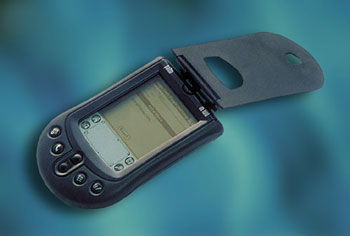 |
The enclosure, at first glance, is associated with plastic toys. It has totally unjustified void - for example, a huge gaping "hole" for a serial cable. Why was it necessary to leave the slot size of 7x27x10 mm is almost impossible to understand (the only highly questionable assumption - use it as an ashtray that can be justified if we recall the "youth" status of the device). The enclosure has rounded shape, the buttons much easier than in the models of Palm III / IIIx / IIIe. Instead of scroll buttons "rychazhkovoy" design used separate buttons that significantly easier. Power button located on the upper edge of the front panel reset button stayed in the same place. Developers have saved on the famous Palm Reset Tool (thin rod in the piece can be unscrewed stylus) - to restart the Palm press the button hidden in the body, and this can only be done by using the aforesaid or instrument, or (as is well known users of older models and have certainly seen many owners Palm m100) any other instrument (usually a paperclip). Palm m100 is equipped with a lid that protects the screen. In this mount is quite witty (two-step, to prevent damage if dropped hinges devices), but not too rigid structure. One of the innovations is the ability to change the faceplate of the case: in addition to the supplied ink supply panel, you can purchase for U.S. $ 19.95 silver (Silver Mist), blue (Blue Mist), greenish (Green Mist), light turquoise (Pacific Blue) or (Ruby Pearl). The device is equipped with a CPU Motorola Dragonball EZ/16 MHz, 2 MB RAM and 2 MB of ROM. 2 MB of memory is enough for the user, a typical program for PalmOS takes about 15-27 Kbytes. Much worse that the creators used a Palm m100 mask ROM, users can not, for example, upgrade the OS. In addition, the absence of PROM can not get back copies of these programs, such as crack. The device runs on two batteries (AAA) for about a month (for "sredneintensivnom" use).The set is no standard for the previous models' stand-dock ", but there is cable to synchronize data. Palm m100 runs under Palm OS 3.5.1 - the latest at the time of our test version of the PalmOS. This significantly altered a suite of applications - for example, no utilities Expense (cost control), Mail (work email) and Subsystem Network HotSync (synchronization in a local network with such a decision could be accepted, very few have ever used this feature) . In addition, there are several new programs. NotePad utility is a text editor with features I "draw" notes, and it starts by pressing a button MemoPad. The main drawback of NotePad - the opportunity to enter only one (!) Line of text. Developers seem to have assumed that users will prefer to draw on the screen using "digital ink" and not bothering to study entry system Graffiti. This solution other than call an error can not be one of the main advantages of Palm - the ability to recognize handwriting and work with text strings that you can search, sort, edit. User, of course, can change the buttons (in the Control Panel Buttons have the appropriate tools), but experience shows that after the first reboot on this button again "assigned" utility NotePad. Program Clock (watch) displays the time, and you can see the time when device is turned off by pressing the scroll button (in the lid of the device are available for this hole and a small window). This is an extremely controversial model, the development of which implied a certain intrigue. About a year before the unit left the company, Palm Computing, its founders, who once created the first Palm (then Palm Pilot). And the Palm m100 is the first model, which was almost fully developed under the guidance of new managers. As a result, this device is a combination of the original concept, Palm and new trends. As is well known, popular Palm platform must not so much ideology, "the connected organizer" with a limited set of features, but fast and compact as well-balanced performance in respect of opportunities, prices and sizes. Alas, the creators of the original concept, as already mentioned, left Palm Computing, Palm m100 and designers a sense of proportion is clearly changed, and the price of this product does not meet the set parameters. Compensate for the disadvantages of the new model would cost in the range of 50-70 dollars, but, alas, to achieve this developers Palm m100 failed.
HandSpring Visor Deluxe
After leaving the company to 3Com, the founders of the "cult of Palm Pilot" created his own company - HandSpring. And approximately after a year they announced the creation of "expandable organizer" Visor, the first device based on the PalmOS, providing the possibility of extension. A little later, this PDA has appeared in Russia.
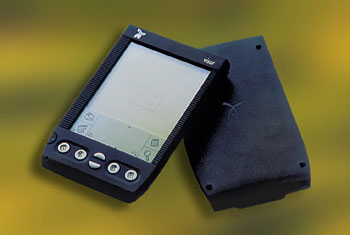 |
We tested the model Visor Deluxe, which at the time of test is the most expensive product in the series Visor. From the standpoint of the technical parameters of a typical device with PalmOS: organizer with a small LCD touch screen (160x160 pixels), with a few buttons, serial and infrared ports. The main advantage Visor with respect to the "original" Palm - the possibility of expanding functions. The rear panel has a slot for cartridges SpringBoard (this may be a modem, additional memory, backup device information, a pager, even cell phone). But the list of benefits that, in fact, exhausted. Visor developers have not paid due attention to design devices, and in terms of usability and design forethought Visor markedly inferior products, Palm and TRG Products. Housing (proposed several options for different colors, we have been black, but we also saw, and a translucent blue) leaves a sense of fragility and vulnerability. Visor slightly longer than Palm III, but a few millimeters narrower, the thickness of both devices are almost identical.SpringBoard expansion slot is not cut into the body, covered with a lid (as in TRGPro), a straight-away opening, which in standard delivery (in the package which does not include any cartridges) are covered with special plug. If there is no cartridge in the nest center of gravity shifts to the device and work with it becomes less convenient than with the Palm and TRGPro. As the organizer of superior products Visor Palm III series only one - he has a very handy buttons, with a distinct feeling of "clicks." But, as experience has shown, the system has a few awkward screen, not in the sense of mapping information, and in the sense of "feeling" when at work style is used. When our testers evaluated. How easy stylus glides over the screen, almost everyone mentioned some inconvenience, the style seems "stuck". Incidentally, the construction style is very original - not only contains Reset Tool, but a small screwdriver (although not very clear. Why - dismantling the enclosure, the user violates the terms of the warranty). The main disadvantage Visor - so poorly made plastic cover that protects the screen. It is a separate item and "clinging" of the slots in the hull above and below, the user can not be opened with one hand to quickly view any information. The device is equipped with a CPU DragonBall EZ/16, 8 MB RAM and 2 MB of ROM. This decision can not be explained by any practical considerations, because the user has no possibility to upgrade the OS. In this case, Visor running PalmOS 3.1H, a modified version of PalmOS 3.1, which does not provide certain features - for example, allows data from the infrared port between your PC or cell phone and Visor. The package includes a stand-dock-oriented interface is USB, the standard for the Palm platform software (package PalmDesktop subsystem HotSync). In the ROM device "stitched" programs that significantly more powerful software and Palm TRGPro. For example, improved scheduler (DateBk +, which is based on the popular package DateBk3), calculator (which increased the number of operations), provides a new tool World Clock (shows the "world time"), etc. In addition, users in principle (to find Packages we could not) can purchase a program cartridge SpringBoard. Visor expansion slot allows the use of not only memory cards, and any other devices that are currently available in abundance in the market, from MP3-players to the recently announced cartridge with a cell phone (VisorPhone). But the advantage is very, very relative - usually more convenient to work with the individual devices, with the exception of just been mentioned modems and memory cards. In tests on the speed Visor showed average results, in principle, it does not matter to the mainstream users, and the "pro" can use many tools overclocking. The device is powered by batteries (AAA), which is enough for about a month. We tested the energy consumption in the process of creating an image file of RAM in the cartridge SpringBoard and concluded that the less economically Visor uses batteries, not so much because the flash memory in the original cartridges consume more energy, but because of the inefficient organization of the copy procedure. It implies a tentative "formatting" cartridge and copy the contents of RAM. The user has no possibility to create multiple copies or to restore individual programs. As a result, despite the potential for expansion, Visor does not justify its price (perhaps only 2-Mbyte model Visor Solo, which competes in price with the Palm m100, may be to some extent justify the purchase). Its creators seem to be guided not so much the actual practical considerations, many abstract concepts of marketing - surely a very witty and interesting, but little useful to the buyer. The main disadvantage Visor - an ill-conceived design, in addition, acquiring it, the user "attaches" itself to a corporate standard. We can not recommend this device.
TRG TRGPro
TRGPro, which we awarded the difference between "editorial board" is a clone of the Palm III. This device is targeted at power users, but even with its higher price, it has an excellent price / quality. "The developers of this product, understand that the Palm III series models can be, and not as elegant as the Palm V, but much more practical. In TRGPro used virtually the same body as in the models, Palm III, except at its thickness, since it was necessary to place the nest for CompactFlash. Expansion slot located on the top, where the Palm III models was infrared. port, incidentally, remained in place (on board), just a cap that covers the slot CompactFlash, made from transparent to infrared radiation material and does not interfere with work. As in previous models of Palm, in TRGPro have analog control contrast. Developers do not have to change the design of buttons, despite the fact that there is much room for improvement. In addition, the modified sound system - instead of "pezopischalki" is used in speaker and, in fact, a normal sound card (with software volume control). Otherwise, TRGPro - almost complete analog Palm IIIxe.
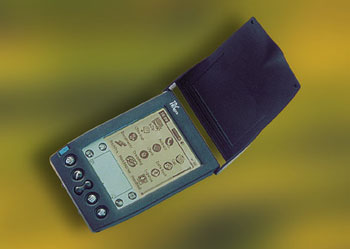 |
TRGPro equipped with a CPU DragonBall EZ/16, 8 MB RAM, 2 MB of EEPROM. In this case, the creators of the device were able to dramatically increase its speed (relative to competitors) - in our application tests (see "Laboratory tests") it has demonstrated excellent results, approximately 35% ahead of HandSpring Visor. It should be noted that in TRGPro uses Palm OS 3.5.1, which, according to many estimates, provides a slightly lower speed (by the way, the use of EPROM leaves the user to decide which version of the OS install). The device runs on two batteries (AAA) for about a month (at sredneintensivnom use). In this case, we evaluated the power consumption of the device (see "Laboratory tests"). However, given the availability of expansion slots, we also evaluated the hog, in the presence of various boards CompactFlash - Flash memory (8 MB) hard drive (IBM Misrodrive) and a modem. As shown by tests, the most "greedy" component (as expected) - the modem, after 10 minutes of work lost 25% of the charge. In this case, the active energy "knocks" a system of forecasting the level of charge in the process of moving the indicator to zero, but want to disable the modem, the indicator shows once again the reality. Fully charged alkaline batteries (we used a battery Kodak) is sufficient for approximately 50 minutes of work with the modem. A similar pattern was observed when using the hard drive IBM Microdrive (340 MB). Our test, which involved intensive and are not characteristic for normal usage load on the external memory subsystem (a few dozen times in a row, with a minute interval, create and delete a copy of the contents of the RAM on the drive, the procedure takes 2.5 h), the device was not finished, exhausted battery after about 1 hour of use. Moreover, after the batteries were depleted by about 50%, we noted an error disk access. However, in tests with flash PROM product proved itself perfectly - battery voltage has dropped to 0.4 In, Visor is "used" 0.9 V. The bundled provides stand-dock, in addition, the device is compatible with stand and peripherals, oriented model, Palm III (for example, we did not note any problems when connecting the modem PilotModem, which, strictly speaking, was created at the time "to Palm III"). In the ROM device "stitched" PalmOS 3.5.1 and a few tools to work with the boards CompactFlash (CFPro and CFBackup). When the user connects the memory card in the list of programs on the Palm home screen icon appears utilities CFPro, which can be used for work with flash memory, and to extract data from the drive IBM Microdrive. File system, which is used in TRGPro, provides a hierarchical directory structure, so that the user has the ability to save, for example, operational data separately from the files - the images of RAM. In this case, unlike the Visor, the program TRGPro much easier.Utility to create files - images of the RAM allows you to prepare any desired number of copies, it provides the possibility of extracting certain files when a user can, for example, to restore only the previous version of the configuration database to any program. We noted a few minor problems - for example, when the full restoration of the contents of the RAM clocks show the time and translated a copy. But the whole concept of working with external memory, compared with Visor, perfect - and for a copy of RAM, and for posting applications can use the same payment (for example, except the files - the images of RAM we installed on the drive IBM Microdrive almost complete library programs for PDA TuCows (pda.tucows.com)). Using the supplied "default", TRGPro buyer has no way to run programs from external memory, it is necessary to copy from the Web-site manufacturer's utility AutoCF. After its launch (we noted cosmetic problem - by default it is assumed wrong "way" in the file system flash PROM, instead of "\", the root directory of the memory card, "prescribed" string "\ TRG") the user can simply move the program in a "category" (similar to "directory" in the PalmOS), which is called AutoCF. Programs that are placed in an EPROM, observed a small square (2CH2 pixel) on the icon. We have not noted any problems in their work. In addition, the package includes that the firm, the developer typically sells a commercial product, - FlashPro. This program allows you to save user information in a flash EPROM, and not only when working with TRGPro, but also on "normal" Palm, equipped with an EPROM. This allows you to make copies of programs that can be used for failure recovery, even when no external memory card. The device is approximately 500 KB of free flash memory. We moved into her crack (the device is equipped with russificator PiLoc 1.2), to some extent, protect themselves from the consequences of failure. TRGPro model for today is the most successful model Palm. Its price is compensated by the functionality, and developers are not forced to overpay for an additional user equipment.
Sony CLIE
The model with the strange name CLIE stands for "Communication. Communicate. Info. Entertainment" (Communication. Link. Information. Entertainment.) - The first "Palm of Sony". The manufacturer touts it as "a multimedia organizer; role, to put it mildly, atypical for the organizers based on the PalmOS, with their traditionally low-power CPUs and small screens.
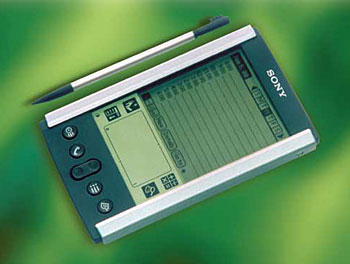 |
As shown by our testing, "multimedia" for Sony CLIE - it's just kind of attitude, marketing mask behind which hides an ordinary (almost) an organizer with PalmOS. We investigated the model of Sony CLIE PEG-S300 with black and white screen that has a standard (for machines with PalmOS) 160x160 pixel resolution and provides a display 16 shades of gray. Diagonal screen size roughly corresponds to the size of the display Palm V; plastic coating allows feather soft and easy to slide on the surface of the screen, not "holding" it for stroke. In length, height and weight CLIE slightly less than the model series Palm III. It can be compared with the Palm Vx, but CLIE about half as thick. Housing CLIE, since the introduction of this model has been the subject of lively discussion and debate. It is rectangular, with both sides of the screen provides metal to form corners (in fact they, like the entire case, plastic). This decision is not due to any technical features, the designers just Sony, it seemed appealing. Here one can argue - as a result housing has become a two-tone, and the presence of brilliant bands around the screen distracting. The huge advantage CLIE - the presence of the manipulator Sony Jog-Dial, which is a "click-wheel." In this case, the standard buttons CLIE many seemed frankly "small" (not enough, especially noticeable when using the scroll button).The design of the nest to place the pen in the CLIE is not entirely successful - a fairly large protrusion on the tip of the pen, for which it "pulls" from the PDA, can cling to any object, for example, when you carry in your bag. In CLIE not provided cover that protects the screen, but the kit includes a convenient carrying case (it's very easy can be turned into "stand"). This PDA has a slot for cards MemoryStick (it would be strange to see a product with no brand name Sony MemoryStick), which can be used for memory cards, as promised, in the long term it can be used to connect equipment and input-output. Connector is a crack in the hull, and are not covered by either a lid or cap that is hardly the right decision. Fee is fixed by a latch, hidden in the body, the user can simply click on it (the second press allows you to extract a fee); nest is placed just under the index finger, and therefore not ruled accidental pressing. In addition, CLIE is not very clever design the power switch (located near the nest for a pen, about the same place and the model Palm Vx) - he looks like a button that the user instinctively seeks to press, to make efforts directed vertically downward, while the right method - a bit put off her back to the nest for the style (the button is a tiny ledge). However, in general design CLIE, oddly enough, is convenient. And even skeptics, after a short usage notes that the PDA is more convenient than it might seem. An informal test of "convenience" provided for the periodic change in the device test and the opportunity to select an organizer of the available, with TRGPro used almost constantly, CLIE was second, Visor gaining popularity, when testers tried to play, because its buttons are the most convenient and comfortable for control ( We used a package Dreadling, a clone of the popular game Doom for PalmOS); Palm m100 usually idle. When using the Jog-Dial in the standard utilities PalmOS user can usually move the cursor. But in the program, a shell, on the contrary, it just opens up the rotation list of programs where you can select (by turning the manipulator) and run (click) the desired utility. We were somewhat puzzled by such a margin - the user can expect the default behavior of the robot arm (move the cursor, highlighting the current program). CLIE model is equipped with CPU Motorola Dragonball EZ, 8 MB RAM, 2 MB Flash EPROM. In tests on the performance of this model is shared third place with organizer Palm m100 (note that the specific problems it promises, the rate of PIM Palm - a relative term). This model is used lithium-ion battery - is a minus, because the battery is somewhat limits the autonomy of the device. Increase (relative to Palm Vx) thickness allows us to apply the battery, but for some reason the creators did not. However, the power supply CLIE (included) allows you to "be fed" PDA, not only with stand-dock (complete with interface USB), as stipulated in the Palm Vx, but without it (in this case, the Palm Vx users generally pay up to 70 dollars by purchasing a set of Palm V Travel Kit). In tests on power consumption, this model showed approximately the same results. As Visor - for 1,5 hours of operation under load on the I / O voltage of the batteries dropped to 0.9 V. The bundled offers 8-Mbyte board MemoryStick, which has a few tools for managing images and video clips. To manage data on the memory card used by the utility MS Gate (MS does not mean Microsoft, and MemoryStick). You can work with data on the memory card, but will have to install a utility MSAutorun (it is available on the Web-site of the manufacturer). Watching movies on CLIE, to put it mildly, not ideal, not even because this model has a monochrome display (there is a model and color), but because the inertia of the LCD monitor is extremely high (note, however, that it does not interfere with play three-dimensional games). Copying from the web a few videos that are optimized for CLIE, we realized that the "multimedia", this organizer is about the same ratio as the silent movie - it provides only the standard "pezopischalka" which, alas, no sound when they are playing. CLIE model can make a very significant competition to the rest of the clones Palm.Disadvantages of this model: overly original design, a "wet" software and use rechargeable batteries, they are completely offset by the presence of a convenient box, memory card and smart design of the power supply.
Editors PC Magazine / RE 'Choice
TRGPro
We tested devices with the PalmOS, which are sold in Russia, we enjoyed most TRGPro. The developers of this product is not guided by far-fetched marketing concepts, and desire to help the user to solve practical problems completely. Suppose that this device can not be converted to MP3-player or phone, but it is much easier and stronger than Visor. TRGPro compliant with external memory and modems, CompactFlash, in addition, provides reading and writing data to disk, IBM Microdrive (in other words, TRGPro - the world's first "Palm with a hard disk" and a maximum capacity of the IBM Microdrive is 1 GB).
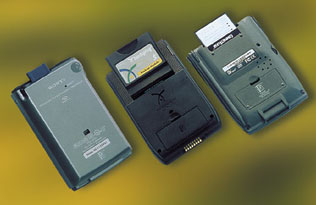 |
Creators model HandSpring Visor, in our opinion, too carried away with the prospects of ideology expands the organizer and did not pay enough attention to ergonomics and usability. Some restrictions Visor does not allow us to recommend you spend your money on the purchase of this PDA. Also, be aware that even for such trivial tasks as creating a file - an image memory in case of malfunction, the owner will have to buy the cartridge Visor SpringBoard, whereas in TRGPro this utility provides a "default". We have not considered the model Visor Platinum, which was announced almost at the time of preparation of this material, but we can assume that it will not change the balance of power in the market, because in addition to the new CPU nothing special is no different. Model Sony CLIE, despite the image of a "multimedia organizer" in terms of "multimedia" is not nothing special is, but it is very convenient and qualitative organizer. We would recommend it, if he has no batteries, and batteries. Determining the winner, we do not take into account the model Palm m100. This device - and ideology, and price - is an attempt to extend the influence of Palm platform into a new market sector. But its creators have not saved those settings in which it would have been justified, and the price of the device, in our opinion, is prohibitive.
Laboratory tests
Speed
| Model | Speed, c * |
| m100 | 16,3 |
| Visor | 14.4 |
| TRGPro | 11,4 |
| Sony CLIE | 16,2 |
| Palm III ** | 16,2 |
* Test methods, see PC Magazine / RE, 6 / 2000, "Lessons from Russian-II". Indicators were measured without Russifiers. ** Results for comparison
Power consumption when operating with external memory
| Model | Voltage drop, V ** |
| m100 | - |
| Visor | 0,9 |
| TRGPro | 0,4 |
| Sony CLI | CLIE0, 9 |
| Palm III ** | - |
* Test meant "run" in the simulation mode "active users" and the recording of test time was 2.5 h. The parameters were measured without Russifiers. Due to the lack of information about the schedule to determine the battery discharge rate in mA-hours is not possible.
Summary characteristics
| Model | m100 | Visor Deluxe | TRGPro | Sony Clie |
| Retail price * | 210 | 345 | 399 | - |
| Processor | DragonBall-EZ/16 | DragonBall-EZ/16 | DragonBall EZ/16 | DragonBall-EZ/16 |
| RAM, MB | 2 | 8 | 8 | 8 |
| ROM MB / style | 1/PZU | 2/PZU | 2/PPZU | 2/PPZU |
| OS Version | PalmOS 3.5.1 | PalmOS 3.1H | PalmOS 3.5.1 | PalmOS 3.5.1 |
| Ports | IR, serial | IR, serial | IR, serial | IR, serial |
| Expansion | - | Built-in cartridge SpringBoard | CompactFlash slot Type III | Built-in MemoryStick |
| Size / mass, mm / r | 115 x 79 x 18/124 | 121x76x17/155 | 121 x 82 x 20/170 | 114 x 79 x 10/125 |
| Food | 2xAAA | 2xAAA | 2xAAA | Lithium-ion battery |
* According to MakTsentr Sources, Materials:




